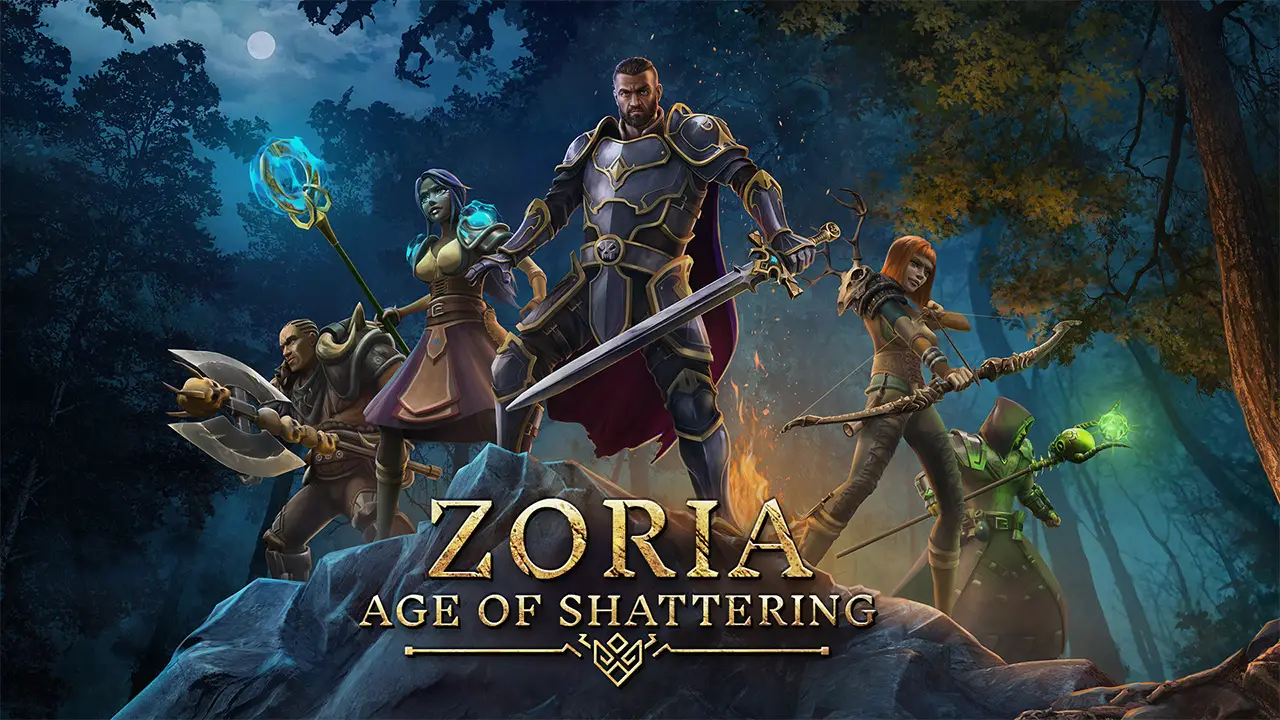Squad-based RPG Zoria: Age of Shattering is a massive indie role-playing game that mixes turn-based combat with base management, follower recruitment, and an extensive crafting system. After the release of a prologue in 2020 and a successful Kickstarter in late 2022, Tiny Trinket Games worked hard to release a fully-fledged 1.0 version in March 2024.
Made by a small team of three people, Zoria promises diverse tactical combat in a world of magic, mystery, and warfare akin to games like Baldur’s Gate and Pillars of Eternity, but is sometimes getting overburdened by the superfluous complexity of its own systems.
Off to a great start?
Having played the demo, I was intrigued to see what changes, for better or worse, had been made to the combat and storytelling in the full game. The main plot isn’t anything you haven’t heard before – a land filled with conflict and power imbalances, left in a vacuum after the end of ‘The Great Fiend War.’ Now, a new threat arises as one particular nation employs the evil magic of necromancy! Your main character served as a commander at a great fortress, part of a chain of bulwarks.
When evil warlocks and their foot soldiers inevitably overran the stronghold, our hero rushed into battle but was nearly killed by a catapult strike. I’m using the past tense because, by the time you reach the character creator, said fortress has already fallen. The remaining forces have gathered at a final fortified position, where our lucky hero regains consciousness among the survivors.
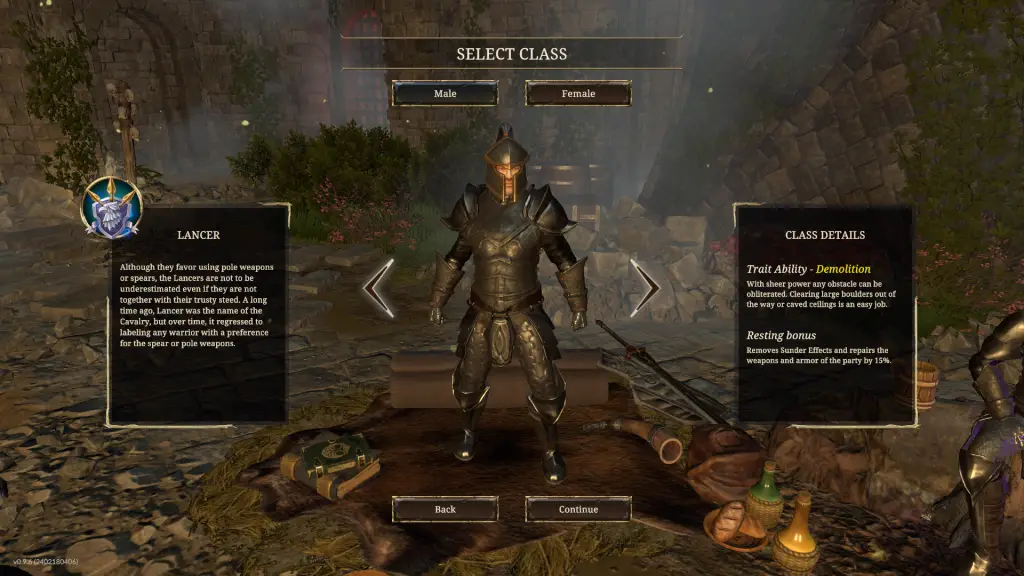
This is where I already struggled to get immersed into the world of Zoria. Having created my character before, I found it hard to believe that a thief could be the commander of an entire stronghold, English folk heroes aside. Even worse was the fact of how seemingly impulsive ─ stupid ─ he reacted at first sight of the enemy, leaving his command post and rushing into his quick demise. It didn’t help that every NPC you talk to seems to know a lot more about the battle than you do, unintentionally rubbing salt into your freshly healed wounds.
There are games that manage to create a dislikeable character due to their motives and beliefs, but, as a player, you find yourself drawn to these kinds of figures because there could be something hidden underneath, something that’s worth the effort to keep up with your main character. To my frustration, over the course of playing, I never felt this way about my avatar. It’s like he always got the most redundant questions or worst one-liners, always one thought behind and rarely asking anything that felt important or meaningful.
The writing, in general, could have really used another look, both for consistency and language issues. As a non-native English speaker myself, I found it quite off-putting how often words were repeated, coming across as uninspired and dull. The dialogue, in general, is serviceable, but I wasn’t really looking forward to new story beats. An odd decision was the partial inclusion of voice-acted lines. This is not entirely new as many games, especially indies, due to the expenses of a fully voiced campaign, decide to offer a compromise: voice the first line of a new paragraph and keep the rest for the player to read on their own.
Unfortunately, Zoria doesn’t abide by a rule, with voices cutting off after three lines or mid-sentence. This creates an unpleasant feeling of uncertainty for the player as you’re never sure when to pick up, moving along with the lines until the voice suddenly stops. The acting itself is rather inconsistent, with characters ranging from incredibly spoken to downright immersion-breaking. Again, this is an indie RPG, but I think less would have been more.
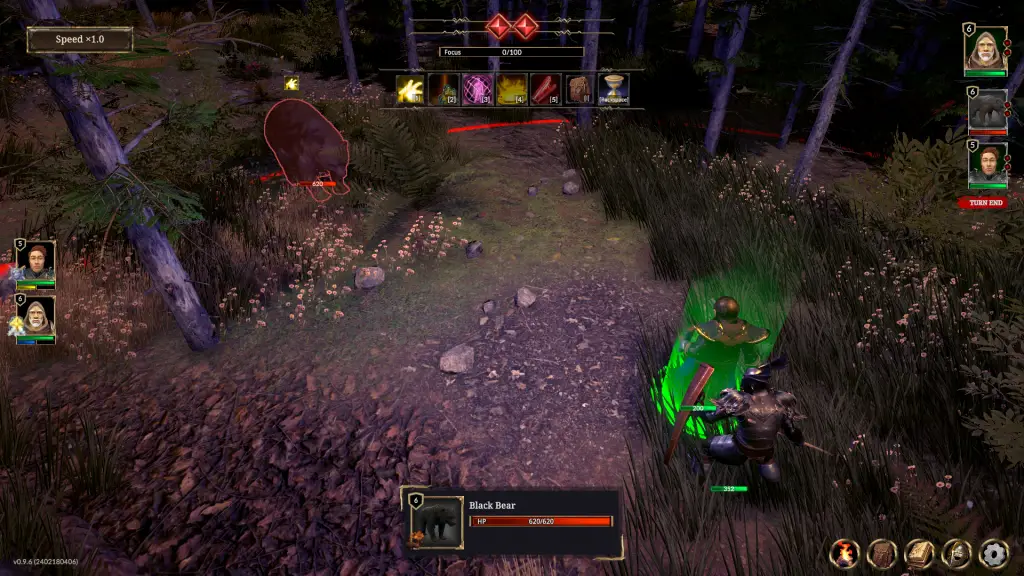
Zoria shines with its abundance of lore and how it is presented to the player. I always liked when games offer a sort of compendium that talks about the different kinds of places, faces, and enemies you’ll meet over the course of your 25-40-hour journey, and this is exactly what we’re getting here. You’ll read about personal histories and backgrounds as well as possible weaknesses in combat that you might want to exploit.
Bring the action
Said combat is far from being tactical, though. This was quite unexpected because Zoria: Age of Shattering offers plenty of jobs to choose from when you’re about to start your adventure: tanky classes like Sentinel and Lancer, from which I chose the latter to be my main character, squishy DPs like Rangers and wizards and support or heal focused priests and clerics. Apart from these archetypes, there are a couple of exotics, like the inquisitorial-looking Nightwarden, fighting with a sword and a crossbow. Each of these has its own unique skill set and should, in theory, take a specific role in combat.
However, once you’re free to roam the countryside, you’ll soon realize that enemies always charge in head-first. You cannot pre-cast any buffs, and you can’t even attack from the outside, even if you already see a group of monsters standing around, begging to be hit by a fireball or a rain of arrows. The combat seemingly runs in turns but is also decided by a stat called initiative. This doesn’t leave much room for strategic decisions because you’ll have to take turns in a line, meaning you cannot wait. It doesn’t matter if your ranger is out of position and unable to hit targets that could move into range if you could delay their turn. Instead, you’re wasting your action points, of which there are generally only two per round.
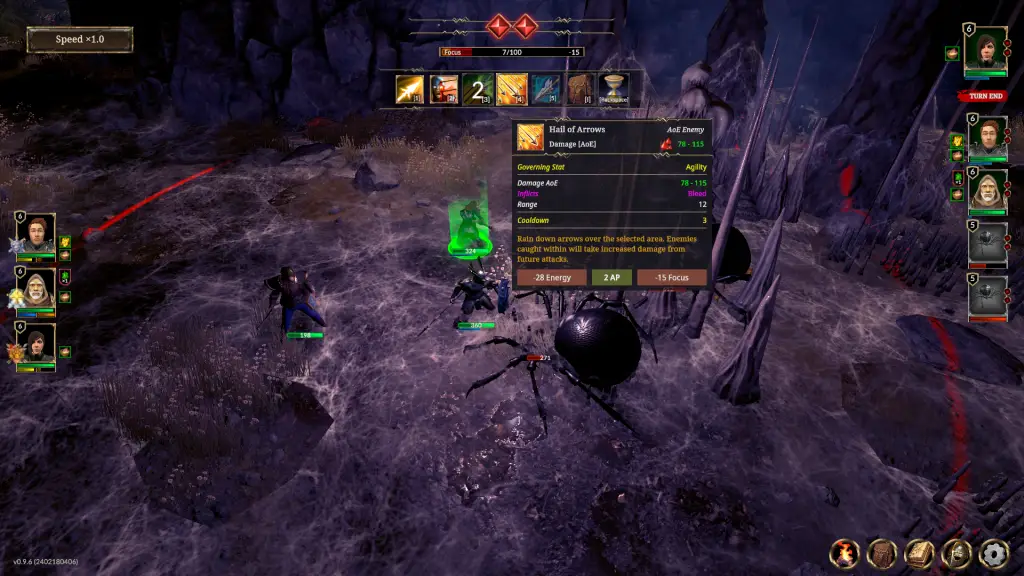
Moving your character always costs at least one action point, even two, depending on the range. However, many skills also need two APs, apart from other resources like mana, energy, and focus. The worst-case scenario looks like this: you’re out of position, have to move in, and, being left with only one AP, you’re forced to use your basic attack. But wait, you cannot use it because there is also a line-of-sight system in place that prevents you from shooting the enemy if an ally is somehow “blocking” your view.
Now you can’t quickly reposition allies and switch back, wasting an entire turn doing nothing. I tried to counteract this by choosing the right formation for my party, but whenever I got into battle, the team fell into a line, like picking up a necklace of carefully arranged pearls. The skills themselves work quite well, and I could spot synergies between different classes, but forcing you to use certain skills for the generation of focus definitely hinders the combat flow.
It’s essentially like your party must always “warm up” before unleashing their deadly potential. Focus isn’t instantly lost after the battle is over, but it will eventually run out. This makes a big portion of the encounters ─ of which there are plenty ─ mindless clickfests. I can see the potential of Tiny Trinked Games here, but it feels like they chose to opt for the least tactical solution.
Every class has a distinct skill tree with diverging paths. This is a great idea to allow for alternative builds even in between the same class. Over the course of the game, you’re going to recruit many companions, and, in theory, you could pick up two lancers and give them different playstyles. Whenever a character levels up, they gain five points to spend on different stats like vitality, strength, and agility and also obtain a couple of skill points at certain leveling thresholds.
By design, it makes sense to put many points into intelligence if you’re playing a sorcerer because it increases the strength of your spells as well as the mana pool. Yet there are classes that seemingly were created once and never balanced afterward. Speaking for my own hero, the Lancer class starts out as a strength-agility hybrid, at least reflected in its skill set. There is a taunting shout, a couple of hard-hitting stabs ─ you get the idea. However, at one point, all attacks lean into the arcane side of combat, meaning every skill scales off of intelligence.
This effectively invalidates many builds unless you put an even number of points into every stat, ending up with a subpar class about everything. The same is true for many other roles. I’m not complaining about min-maxing, but the lack of choice if the ones you’re given force you to either stick with low-level skills or leave them out entirely and turn your character upside down. At least there is no punishment for doing so because you can reallocate your skill points as many times as you want without any penalty.
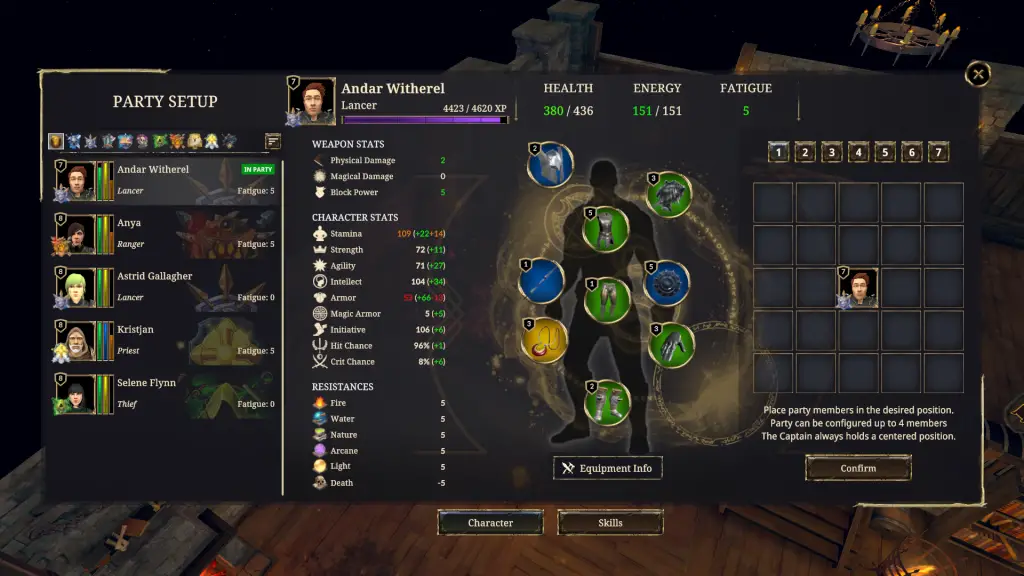
You can freely pick a place to rest with your companions between battles. This offers multiple benefits like decreasing fatigue and a debuff that limps your stats for every consecutive battle without rest. Here is where the class system starts to shine: as mentioned earlier, every class has some unique skills, which isn’t only affecting combat.
My lancer was able to repair our party’s armor and weapons while the priest increased the healing provided. Other specialties stop bleeding or neutralize poison, which is very handy, given the fact that your camping is only limited by the amount of supplies you are carrying. It doesn’t matter if the enemy is 20 metres away, you’d still be good to set up a fire and give your party a much needed rest before the next encounter.
The age of shouldering
The reward for many in-game activities like finishing quests, finding chests, or plain old monster combat is a big pile of loot, mostly consisting of potions, crafting materials, or equipment, which adds some appreciated depth and variety. However, you’ll quickly notice the excessiveness and speed with which your 280 bag slots get filled up. Right at the beginning of the game, after you click through a multitude of screen-filling tutorials, you’re tasked to pick up items as part of an introduction.
It doesn’t take long before you feel overwhelmed by the sheer amount of different ingredients, not to mention the loot. You cannot sort your inventory and, therefore, constantly click through different filtering options to find what you’re looking for. Throughout Act 1, so much loot gets thrown at you that you inevitably start leaving items behind. I tried to understand this excessive approach, and the only reasonable explanation seemed tied to another game mechanic – the outpost. At the end of Act 1, you get a new stronghold, albeit much smaller and rundown.
Here is where you gather the multitude of companions, with dozens of different characters to potentially recruit over the course of the game. Each of them needs gear, so I’d think that the mountains of different white, green, and blue items are meant for them. If that is correct, then the pacing was extremely off and I’d have liked to include a caravan or mule option to lighten my shoulders.
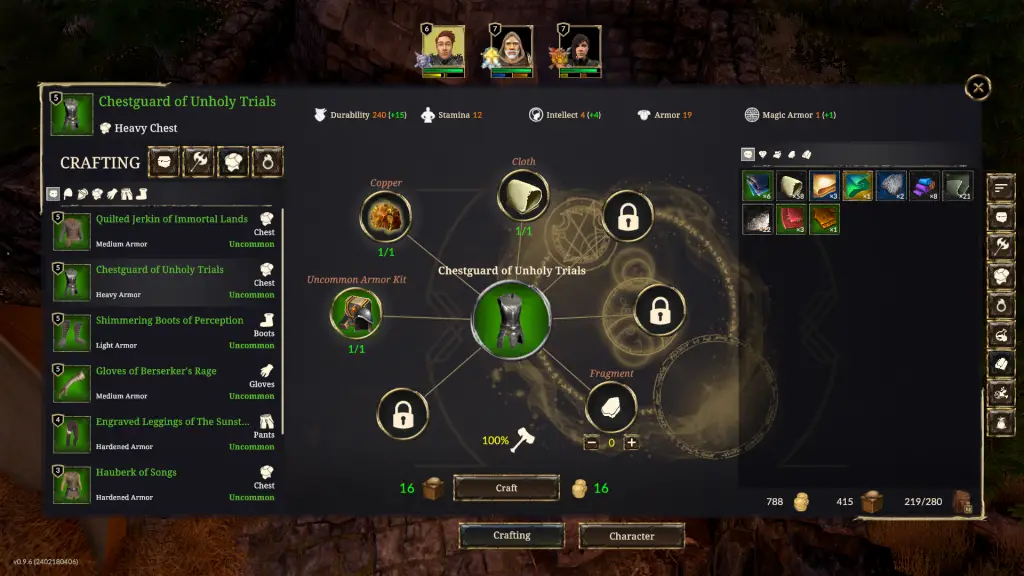
Once you’ve established your outpost and found some new recruits, it’s time to put them to work – your army isn’t just for show. Many classes have essential abilities that help overcome obstacles in the game world: Priests clear the cursed ground, Lancers easily deal with rocks and debris, and your Hunter spots and disarms traps. This is both a blessing and a curse, as it forces you to carefully consider your party’s composition, offering more gameplay variety.
However, it also means you have to backtrack, pick up a mercenary you’ll likely never use otherwise, clear the obstacle, return to your outpost, and reform your preferred party. If there was a means of teleportation, I wouldn’t mind this system, but currently, it unfortunately feels like a prolonged waste of time. Recruits who would otherwise procrastinate all day long in your outpost have the option to be sent on missions. These work like idle games in which you pick a team, pick a mission, and wait for the timer to end before they return with rewards in the form of experience and items. I think this is a great way to make you feel like the actual commander of an outpost despite the limited interactivity.
Conclusion
Bugs weren’t part of my review because, with an RPG of this size, you have to expect, accept, and live with them. Baldur’s Gate 3 included over 1,000 bug fixes multiple times in each update, so naturally, a team of three developers faces the same issues. Instead, one of my biggest gripes was the uninteresting main character and how everyone around him seemed to know much more but didn’t bother to explain further, essentially creating an ellipsis.
In narrative theory, an ellipsis is any gap in a story that leaves out parts of the narrative, requiring the audience ─ us ─ to fill in the missing pieces with their imagination. This technique can be used to create suspense and mystery or to focus the narrative on specific elements. However, when overused or not executed carefully, it can leave players feeling lost or frustrated if crucial information seems missing or if the ellipsis doesn’t enhance the storytelling but rather complicates the plot. Zorias’ world has plenty to offer but I always felt like I was missing out on something.
I love the old-school vibe oozing from its world design, and the overall look doesn’t have to shy away from bigger titles. However, I think that Zoria suffers from an extensive feature bloat. It might be the perfect example of a game that should have been put into early access first, sticking with its solid core RPG pillars. After gaining player feedback, more traits could have been added. I’m sure people would have commented on the display-size, multi-sided tutorial screens, which completely disconnect the player from their character.
The added crafting, armor, and weapon smithing might feel necessary for such a game, when in reality, I never felt the urge to utilize any of it, being too busy to crawl through all the stuff that made my pockets burst already. There are so many systems in place, and Tiny Trinket certainly didn’t want to cut any of them, which led to unoptimized outcomes like the unintuitive skill progression for multiple classes.
Many issues listed here might not matter as much to you as they did to me though. If you’re looking for a straightforward combat experience in a fantasy world that offers a wide assortment of different progressions, Zoria: Age of Shattering could be the perfect match. However, a lack of strategic depth and inconsistency in its writing highlights all too well that Zoria tries to be a jack of all trades but is clearly a master of none.
Author’s Note: This review was written prior to the release of the game’s version 1.04 update. It improves the combat system and addresses parts of the major criticisms like wasting action points and resource management in combat. Players are now allowed to freely move around for 7 meters before they actually have to spend an action point, keeping the combat flowing much more smoothly than before the 1.04 update dropped. This also solves the issue with line-of-sight, at least partially. In many cases, there is now the option to slightly move your character without feeling punished all the time.
Overall, this was a much-needed update and feels like an actual improvement to the game, also highlighting that the development team is actively listening to community feedback. It doesn’t fix the game’s overloading systems and storytelling issues, but it makes the combat much more enjoyable. Let’s hope that the enemy AI also gets an upgrade in one of the upcoming updates so Zoria could actually start to feel like a tactical RPG.

